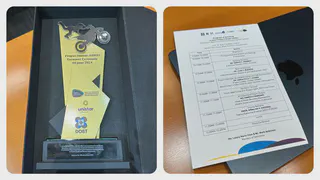Driving Efficiency Innovation Through Enterprise AI Collaboration

In today’s rapidly evolving tech and business landscape, the ability to innovate and adapt is critical for enterprises to maintain their competitive edge. Collaboration between academic institutions, industry partners, and government can be pivotal in driving meaningful innovation.
On June 18, 2024, at the Asian Institute of Management (AIM), we concluded a two-year AI R&D project that exemplifies this triple helix collaboration. Partially funded by the Department of Science and Technology, our partnership with Unistar Credit and Finance Corporation demonstrates the power of data science and AI in transforming business processes.
The Project’s Genesis
The project began with a clear objective; that is, to enhance the efficiency of Unistar’s repossessed motorcycle evaluation process. Traditionally, evaluating and classifying a repossessed motorcycle into different quality categories took about one man-hour. However, with the volume of repossessed motorcycles increasing from 3,000 per month in 2022 to 5,000 in 2024, the need for a more efficient solution became imperative.
The Collaboration: Developing Ensemble Deep Learning Models
Our DSAI team at AIM took on the challenge by developing ensembles of deep learning (DL) models. These models, highly customized for Unistar’s needs, utilize text, image, and audio data to automate the assessment process. Two general frameworks were introduced. The first one builds three separate AI models for each data mode and then subsequently builds an ensemble model combining the three models. The second framework is an ensemble DL model combining all three modes of data.
We’re very pleased with the result—the evaluation time has been reduced from one hour to just five minutes per motorcycle; note that the processing can even be done concurrently. I was also happy to hear the vote of confidence from our industry partner. They emphasized that this significant reduction in processing time not only enhances operational efficiency but also sets a new standard in the industry for automated quality assessment. In addition, the cost reduction impact of the work could spill over to Unistar’s clients with cheaper rates as the process has been significantly streamlined.
Operationalizing the AI System
A critical aspect of this project was the seamless integration of our AI model with Unistar’s existing IT system. This allowed for real-world testing and deployment, ensuring the model’s practical viability. The path to deployment was challenging, emphasizing the importance of close collaboration and continuous feedback between our technical team and Unistar’s IT department. We commend our collaborators for their readiness and openness, which were essential for the project’s success.
A Successful Triple Helix Collab

As the Project Leader, I’ve had the privilege of witnessing firsthand how this endeavor exemplifies the power of triple helix collaboration. Our project’s success stems from the seamless integration of academia, industry, and government support. The exceptional cooperation, proactivity, and flexibility of our industry partner, Unistar, were instrumental. We extend our heartfelt gratitude to Ernesto Manzano and Aaron Gatlabayan for their unwavering support throughout the project.
The dedication of our team members from AIM’s ACCeSs lab has been truly commendable. Special thanks go to Leodegario II Lorenzo (the project’s technical lead), Kristine Ann Carandang, Imee Delos Reyes, and Jasper Daguplo. They worked tirelessly under the close supervision of Acd. Christopher Monterola, conducting site visits to Unistar offices and facilitating knowledge sharing sessions to ensure effective implementation and adoption of our innovation.
We also express our sincere appreciation to the Department of Science and Technology, particularly Dir. Enrico Paringit, for their support and partial funding. Their belief in our work has been a driving force behind our success. This project stands as a testament to what can be achieved when academia, industry, and government collaborate effectively. As we look to the future, we’re excited about the potential for more such partnerships to drive innovation and create real-world impact. It’s through these collaborative efforts that we can continue to push the boundaries of technology and its applications in business, ultimately contributing to economic growth and societal progress.